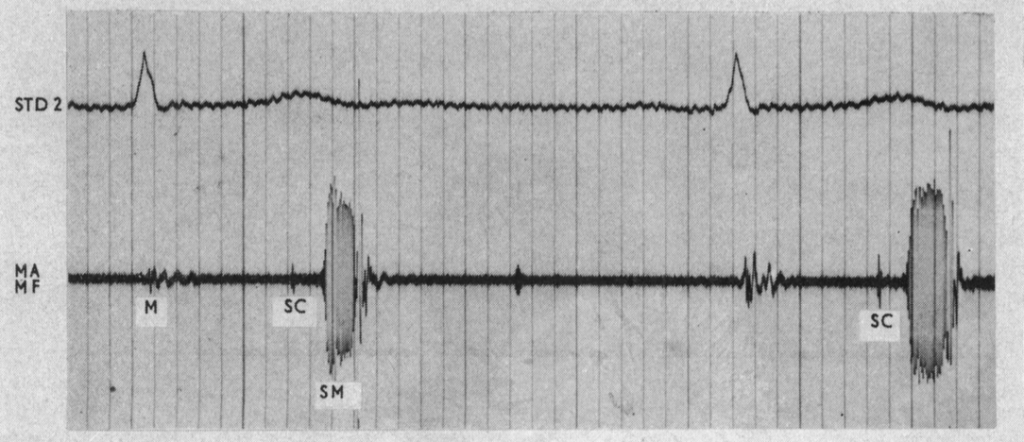John Barlow

John Brereton Barlow (1924-2008) was a South African cardiologist
World authority on cardiology, best known for his work on the pathogenesis and mechanism of late systolic murmurs and mitral non-ejection clicks
Barlow described mitral valve prolapse (eponymously known as Barlow’s syndrome), though would probably have preferred the term ‘billowing posterior mitral leaflet syndrome’.
In the early 1970s and at the height of apartheid, Barlow (with Margaret McLaren) performed a major epidemiological study of the high prevalence of rheumatic heart disease in Sowetan schoolchildren. Publication in the international literature of this poor reflection of the socio-economic conditions of the South African black population was not achieved without criticism from the government of the day.
Biography
- Born on October 24, 1924 in Cape Town
- 1939 – commenced medical school at the University of Witwatersrand
- 1940-1945 enlisted with the South African forces attached to the British Eighth Army in North Africa and then the American Fifth Army in Italy, returning to medical school 1946
- 1951 – MB BCh Wits.
- 1952-1955 internships and registrar posts at Baragwanath Hospital, Soweto
- 1955 – MRCP; commenced work as registrar to Sir John McMichael (1904-1993) at Hammersmith Hospital and the Royal Postgraduate Medical School in London under Dame Sheila Sherlock (1918-2001)
- 1958 – return to South Africa training in cardiology at Johannesburg Hospital
- 1961 – chief of the Cardiovascular Division at the University of the Witwatersrand
- 1971 – head of the Cardiology Unit, Johannesburg Hospital
- 1968 – MD
- 1980 – Professor of Cardiology, Johannesburg Hospital
- 1990 – honorary doctorate of science in medicine, Witwatersrand
- Died on December 10, 2008
Medical Eponyms
Barlow syndrome (1968)
Barlow syndrome (primary billowing mitral leaflet syndrome (BMLS)) is an often-used and more often misused diagnosis. It is a condition characterized by the displacement of an abnormally thickened mitral valve leaflet into the left atrium during systole with auscultatory findings of a late systolic murmur with non-ejection (‘mid-late’) systolic click
1963 – John Brereton Barlow (1924-2008) and colleagues used cine-ventriculography, to demonstrate conclusively apical late systolic murmurs as being the result of mitral regurgitation. They concluded that the associated “clicks are likely to arise from an intracardiac cause”. Barlow wrongly ascribed the findings to fibrosed chordae due to rheumatic valve disease and recommended that patients be placed on antibiotic therapy against rheumatic fever
The original paper was rejected by the principal scientific journals of the time on the grounds that it was “too extreme to claim that the cause was due to the mitral valve mechanism” instead being published by the Maryland State Medical Journal. This led to the American Heart Journal publishing “The significance of late systolic murmurs”, with the description of auscultatory findings in seven patients, later that year.
1968 – Barlow demonstrated that the click originated in the mitral valvular complex. It was the result of billowing of one of the mitral leaflets, which in turn was the consequence of uneven distribution of tension in the chordal mechanism.
Evidence has previously been produced from this laboratory that apical late systolic murmurs denote mitral regurgitation, and that the commonly associated non-ejection systolic clicks also have an intracardiac, and probably chordal, origin. It has also been suggested that the association of these auscultatory features with a distinctive electrocardiographic pattern and a billowing posterior leaflet of the mitral valve constitutes a specific syndrome.

FIG. 2.-Phonocardiogram, recorded in mid-expiration, of a musical late systolic murmur in a 15-year-old girl. A non-ejection click is also present. Left ventricular cine-angiocardiography demonstrated mild mitral regurgitation and abnormal billowing of the posterior leaflet.
Abbreviations: MA=mitral area; MF=medium frequency; SM= systolic murmur; SC=systolic click; M=mitral component of first heart sound. The distance between the heavy vertical lines equals 0-20 sec. Barlow 1968
Barlow identified patients with specific auscultatory findings who displayed clinical abnormalities including ECG changes compatible with inferior myocardial ischaemia, and a variety of dysrhythmias. He also presented a case demonstrating pathologic correlation
A 39-year-old man with phonocardiographic confirmation of a late systolic murmur and non-ejection click, died suddenly while mowing a lawn: no cause of death was established at necropsy nor was any coronary artery abnormality detected. We later examined the mitral valve which had an extremely voluminous posterior leaflet and thin elongated chordae tendineae.
1992 – Barlow had described a specific “auscultatory-electrocardiographic” syndrome characterized by a billowing leaflet, with protrusion of the leaflet body to the atrial side, above the annulus, without the significant regurgitation that characterizes prolapse. The differences can be clearly identified with the echocardiogram. Barlow very much disliked the term prolapse
…Criley et al. introduced in 1966 the term ‘prolapse’ of the mitral valve…We contend that attempts to asses so-called ‘mitral valve prolapse’ (MVP) based principally on variable echocardiographic criteria and with ongoing use of Criley’s terminology, are misleading and compound the present confusion… It is thus regrettable that the term is used even when the valve anomaly is mild, clinically silent, and functionally normal.
Variously called primary mitral valve prolapse (MVP), floppy valve, myxomatous leaflet, click-murmur, or Barlow syndrome, the term billowing mitral leaflet (BML) syndrome is preferred.
So-called ‘mitral valve prolapse’ ranges from an insignificant normal variant to an important and
potentially fatal cause of mitral valve disease. We must learn neither to overtreat the former nor to
be negligent in our neglect of the latter!
Major Publications
- Barlow J, Shillingford J. The use of amyl nitrite in differentiating mitral and aortic systolic murmurs. Br Heart J. 1958 Apr;20(2):162-6.
- Barlow JB. Some observations on the atrial sound. S Afr Med J. 1960 Oct 15;34(42):887-92
- Barlow JB, Pocock WA, Marchand P, Denny M. The significance of late systolic murmurs. Am Heart J 1963; 66: 443-452
- Barlow JB, Pocock WA. The significance of late systolic murmurs and mid-late systolic clicks. Md State Med J. 1963 Feb;12:76-7.
- Barlow JB. Conjoint clinic on the clinical significance of late systolic murmurs and non-ejection systolic clicks J. Chron. Dis. 1965; 18(7): 665
- Barlow JB, Bosman CK. Aneurysmal protrusion of the posterior leaflet of the mitral valve. An auscultatory-electrocardiographic syndrome. Am Heart J. 1966 Feb;71(2):166-78
- Barlow JB, Bosman CK, Pocock WA, Marchand P. Late systolic murmurs and non-ejection (“mid-late”) systolic clicks. An analysis of 90 patients. Br Heart J. 1968 Mar;30(2):203-18.
- Barlow JB, Pocock WA: Billowing, floppy, prolapsed or flail mitral valves? Am J Cardiol 1985; 55: 501-502
- Barlow JB, Pocock WA. Mitral valve prolapse, the specific billowing mitral leaflet syndrome, or an insignificant non-ejection systolic click. Am Heart J. 1979 Mar;97(3):277-85.
- Barlow JB. The “false positive” exercise electrocardiogram: value of time course patterns in assessment of depressed ST segments and inverted T waves. Am Heart J. 1985 Dec;110(6):1328-36.
- Barlow JB. Perspectives on the Mitral Valve. 1986
- Barlow JB, Pocock WA. Mitral valve billowing and prolapse: perspective at 25 years. Herz. 1988 Aug;13(4):227-34
- Barlow JB. Mitral valve billowing and prolapse–an overview. Aust N Z J Med. 1992 Oct;22(5 Suppl):541-9
To all the students who listen, look, touch and reflect: may they hear, see, feel and comprehend
References
Biography
- Sternbach G, Varon J. John Barlow: mitral valve prolapse. J Emerg Med. 1993 Jul-Aug;11(4):475-8.
- Antunes MJ. Professor John Barlow – The Legend. Rev Port Cardiol (Engl Ed). 2020 May;39(5):233-236. English, Portuguese.
Eponymous terms
- Anyanwu AC, Adams DH. Etiologic classification of degenerative mitral valve disease: Barlow’s disease and fibroelastic deficiency. Semin Thorac Cardiovasc Surg. 2007 Summer;19(2):90-6.
- Melnitchouk SI, Seeburger J, Kaeding AF, Misfeld M, Mohr FW, Borger MA. Barlow’s mitral valve disease: results of conventional and minimally invasive repair approaches. Ann Cardiothorac Surg. 2013 Nov;2(6):768-73.
- Mestres CA, Piñón MA, Quintana E. Commentary: The Barlow valve: Understanding disease and symmetry. JTCVS Tech. 2021 Oct 9;10:66-67.
Eponym
the person behind the name
BA MA (Oxon) MBChB (Edin) FACEM FFSEM. Emergency physician, Sir Charles Gairdner Hospital. Passion for rugby; medical history; medical education; and asynchronous learning #FOAMed evangelist. Co-founder and CTO of Life in the Fast lane | On Call: Principles and Protocol 4e| Eponyms | Books |
